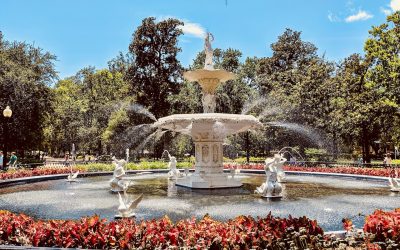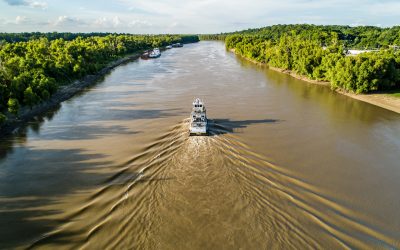Nebraska has something very cool (it’s actually hot and humid) that no other state has: it’s home to Lied Jungle, the world’s largest indoor rainforest at the Henry Doorly Zoo in Omaha. Rainforests are, of course, outdoor forests that get anywhere from 79 inches to 394 inches of rain every year. Do you know how many inches of rain your state gets?
This indoor rainforest, however, is eight stories high and enclosed in glass. It contains about 2,000 different types of plants and 125 different animals (some are exotic), ranging from monkeys and macaws (colorful parrots with long tails) to pygmy hippos.
BUT, besides the Lied Jungle, there’s a lot more that Nebraskans can brag about like the 911 emergency communication system used all over the country. It was developed and first used in Lincoln, which is the capital of Nebraska and the state’s second largest city. Kool-Aid was also invented here as well as frozen TV dinners and chair lifts for ski resorts.
Nebraska is surrounded by six states: South Dakota to the north, Colorado and Kansas to the south, Wyoming to the west, and Iowa and Missouri to the east. As the 37th state to join the United States in 1867, Nebraska has a proud history and diverse environment, ranging from farms and wetlands to sand dunes.
What really happened
- About 12 million years ago, a volcanic event killed animals like saber-toothed deer (you thought we were going to say saber-toothed tigers, right?), raccoon dogs, and giraffe-like camels. Their fossilized remains are located at Ashfall Fossil Beds in northeastern Nebraska.
- People have inhabited Nebraska for thousands of years. When the first European arrived in 1541, a Spanish explorer named Francisco de Coronado, there were several tribes of Native Americans living throughout the state. In the west, there were the Cheyenne and the Lakota Sioux tribes who lived in tepees and followed the bisonherds that were the source of their food, clothing, and shelter. In the east lived the tribes of the Omaha, Pawnee, and the Otoe who lived in more permanent lodges made from earth and sod. They hunted buffalo but farmed much of their food, planting crops of corn, beans and squash.
- Starting in the 1500s, French and Spanish explorers claimed the land for their country but left much of it unexplored.
- In 1803, the United States purchased a large region of land from the French that included Nebraska and other states west of the Mississippi River. It’s known as the Louisiana P American explorers named Lewis and Clark traveled through Nebraska in 1804, mapping their trip and reporting back about the flat plains and large herds of bison they saw in the state.
- The United States established Fort Atkinson in 1819, the first army post built west of the Mississippi R
- In 1862, during the Civil War, the Homestead Act allowed people to get free land in Nebraska in exchange for building and farming the land for five years. New railroads crossing the territory also made it much easier for people to travel there. The population of the territory grew quickly and it became a state in 1867.
- Omaha was the territory’s capital when it became a state. But the capital was later moved to Lancaster, which was renamed Lincoln, after President Abraham Lincoln was assassinated in 1865.
- In the late 1800s, most of the Cheyenne and Sioux were forced to move to Indian Territory in Oklahoma while farmers and cattle ranchers began to occupy the land.
- During the1800s, Nebraska experienced many natural disasters, ranging from droughts and blizzards to even grasshoppers. The 1870s are remembered as grasshopper years in the state. The worst period was July of 1874 when swarms of hungry grasshoppers raided the Great Plains, devastating crops.
Stuff you should know
- Nebraska’s fertile soil is ideal for growing crops because of an underground water supply called the High Plains Aquifer. That’s one reason why the state is called the “breadbasket of America.”
- The state has more miles of river than any other state.
- Since 1937, it has been the only state in the country with a single house legislature called a Unicameral Legislature. All other states are bicameral, which means they are made up of two separate bodies: the Senate and the House of Representatives. Nebraska has just one House and its members are called senators.
- In 1872, J. Sterling Morton, a Nebraska newspaper editor and politician, proposed a holiday to promote the planting of trees in Nebraska. Approximately one million trees were planted that year. Can you guess the name of the holiday? …It’s Arbor Day! By 1920, 45 states had adopted the holiday.
- Like popcorn or corn on the cob? Nebraska is nicknamed the Cornhusker State. It’s one of four states that produce more than half of this country’s corn. The other three states are Iowa, Illinois and Minnesota.
Crazy, funny, or just plain weird
- The largest porch swing in the world is located in Hebron, Nebraska. Twenty-five adults can sit on it at the same time!
- The University of Nebraska-Lincoln’s weight room is the largest in the country. It covers three-fourths of an acre.
- On June 22, 2003, severe storms produced tornadoes and destructive flooding in several counties, but giant hail fell in the city of Aurora. People reported that some hailstones were the size of volleyballs. The impact made by these hailstones left huge craters in the ground. Some craters were as large as 12 inches and more than three inches deep on grass lawns.
Tell me more
- The name “Nebraska” comes from the Oto Indian word “nebrathka,” meaning “flat water.” This name originally referred to Nebraska’s Platte River.
- Farms and ranches take up 92 percent of the state’s total land area.
- The coldest temperature ever recorded in the state was -47 degrees Fahrenheit in Oshkosh on December 22, 1989. That’s a difference of more than 160 degrees for the all-time highest temperature of 118 degrees Fahrenheit recorded in Geneva in July of 1934.
- Nebraska can be divided into two major regions. The Dissected Till Plains cover the eastern quarter of the state. When glaciers melted at the end of the last Ice Age, they left behind till, which is a mixture of sand, gravel and boulders. The other region is the Great Plains, which covers the rest of the state. This region is flat with a few canyons, valleys, lakes and wetlands.
- Central Nebraska boasts the biggest spread of the mounds in North America. Called the Sand Hills, the dunes stretch for about 20,000 square miles!
Do you have a fun fact or story you’d like to share with other kids about Nebraska? If so, we’d love to hear it! Email it along with your first name, age, and state where you live and we’ll post it on our social media pages. Perhaps we’ll even make up a Trivia Tuesday question using your contribution!







